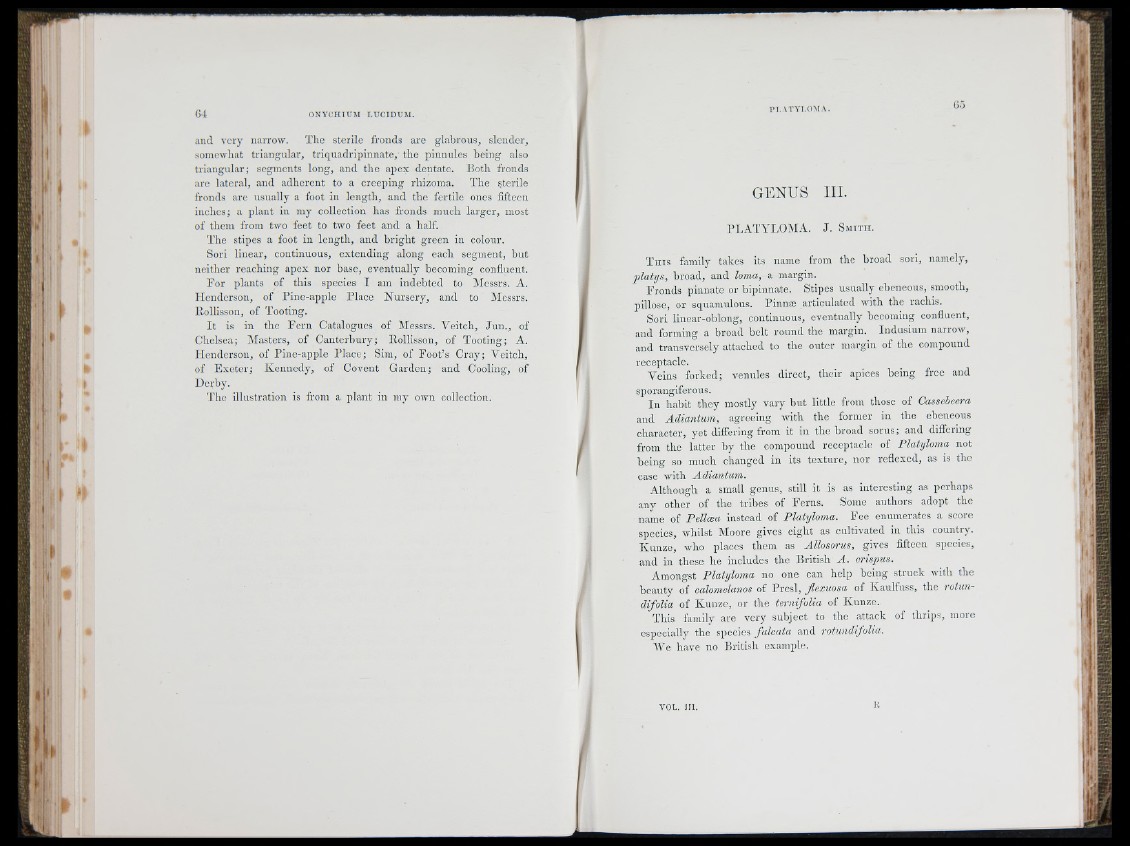
<1
ct
P I . V TYl .OM.V.
î ‘
U
and very narrow. Tlio sterile fronds are glabrous, slender,
somewhat trian g u la r, triq u a d rip in n a te , the pinnules being also
tria n g u la r; segments long, and th e apex dentate. Both fronds
are lateral, and ad h e ren t to a c reeping rhizoma. T h e sterile
fronds are usua lly a foot in len g th , and the fertile ones fifteen
inches; a plan t in my collection has fronds much la rg e r, most
of them from two feet to two feet and a half.
T he stipes a foot in len g th , and b rig h t g reen in colour.
Sori linear, continuous, ex ten d in g along each segment, b u t
n e ith e r reaching apex nor base, eventually becoming confluent.
Tor plants of this species I am in d eb ted to Messrs. A.
H en derson, of Pin e -ap p le Place N u rse ry , and to Messrs.
llollisson, of Tooting.
I t is in th e F e rn Catalogues of Messrs. Veitch, Ju n ., of
Chelsea; Masters, of C a n te rb u ry ; Eollisson, of T ootin g ; A.
H en d e rso n , of P inc-applc P la c e ; Sim, of F o o t’s C ra y ; Veitch,
of E x e te r; K en n ed y , of Coveut G a rd en ; and Cooling, of
D erby.
T h e illustration is from a plan t in my own collection.
GENUS in.
P LA T Y L OM A . J . S m i t h .
T h is f am ily ta k e s it s n am e f rom th e b r o a d s o r i, n am e ly ,
p la tijs, b r o a d , a n d loma, a m a r g in .
Fronds pinnate or hipinnate. Stipes usually ebeneous, smooth,
pillóse, or squamulous. P innæ a rticulated with the rachis.
Sori linear-oblong, continuous, eventually becoming confluent,
and forming a broad b e lt ro u n d the margin. In d u sium narrow,
and transversely attached to the outer margin of th e compound
receptacle.
Veins fo rk ed ; venules direct, their apices being free and
sporangiferous.
I n h ab it th ey mostly vary b u t little from those of Casscheera
and A d ia n tum , agreeing with the former in th e ebeneous
character, y e t differing from it in th e broad sorus; and differing
from the latte r b y th e compound receptacle of P latyloma not
being so much changed in its te x tu re , no r reflcxcd, as is the
case with A d ia n tum .
A lth o u g h a small genus, still it is as interesting as perhaps
any other of the tribe s of F erns. Some authors adopt the
name of P ellæa instead of P latyloma. F e e enumerates a score
species, whilst Moore gives eig h t as cultivated in this country.
K u n z e , who places them as Allosorus, gives fifteen species,
and in these h e includes the British A . crispus.
Amongst Pla ty loma no one can help being stru ck with the
be au ty of calomelanos of P re sl, fle xu o sa of Kaulfuss, the rotun-
difolia of K u n z e , or the ternifolia of Kunze.
This family are very subject to the attack of th rip s, more
especially the species fa lc a ta and rotundifolia.
AYe have no British example.
VOL. m.